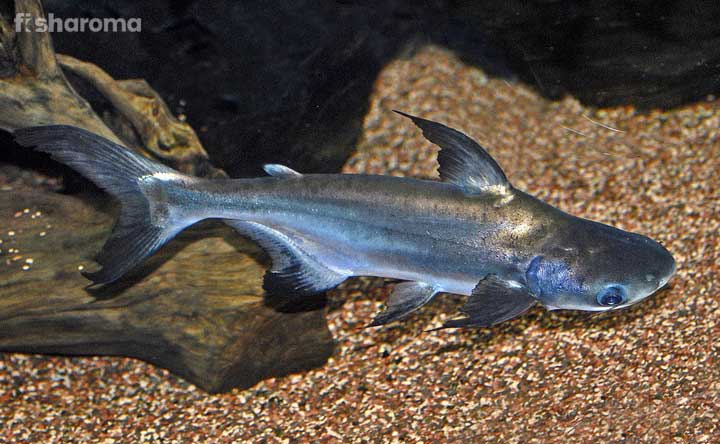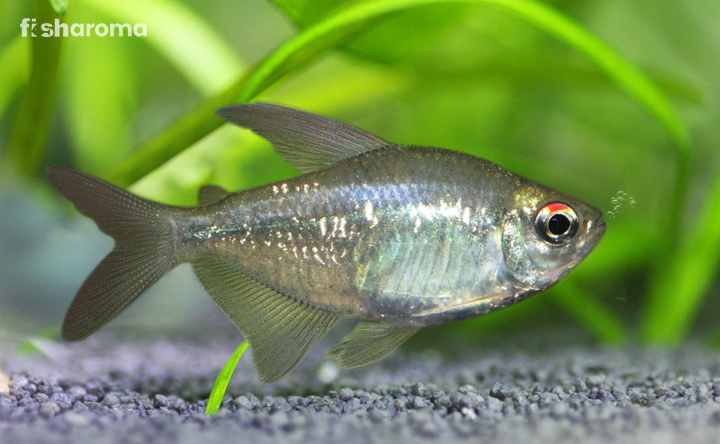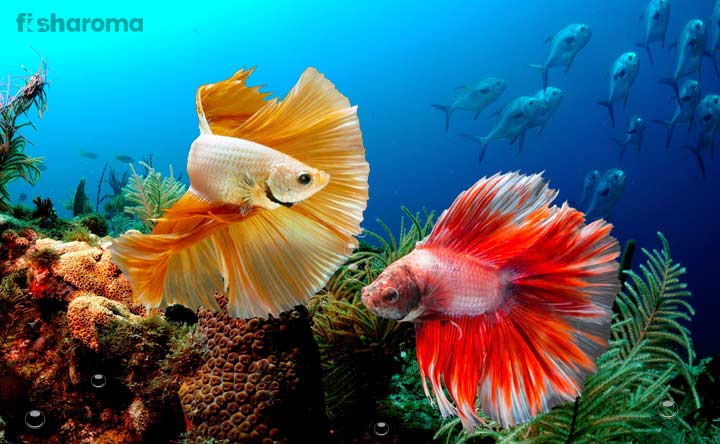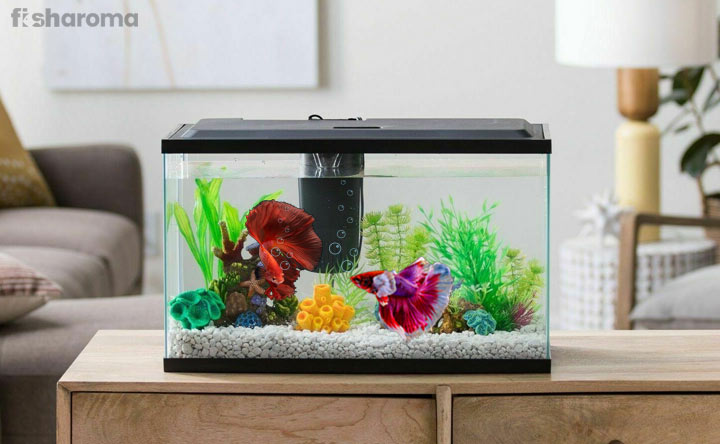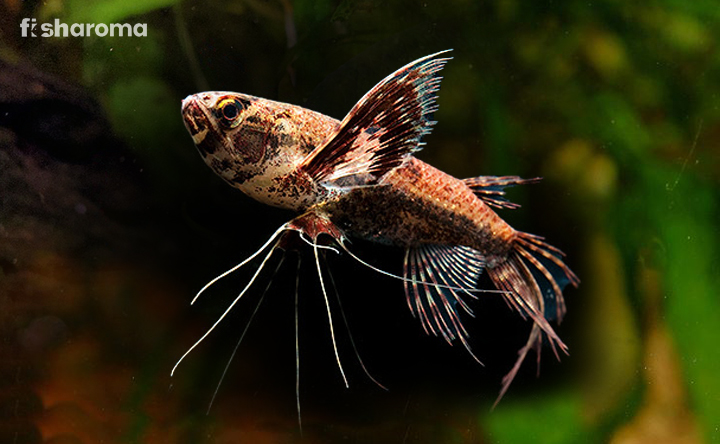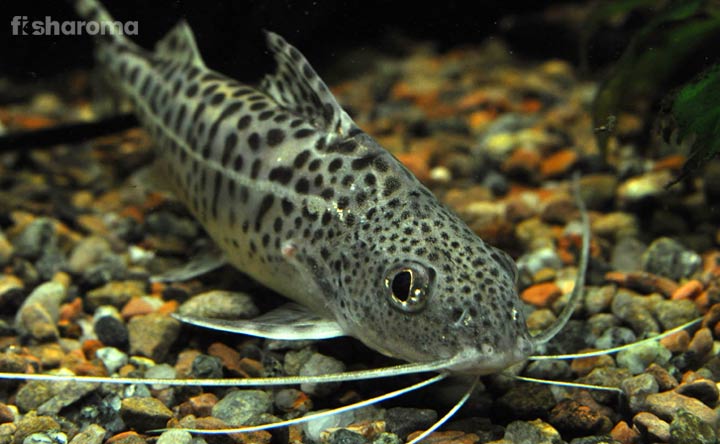Snakehead Fish – Types And Relevant Care Guide

- Origin And Habitat Of Snakehead Fish
- Appearance Of Snakehead Fish
- Behaviour Of Snakehead Fish
- Lifespan Of Snakehead Fish
- Diet Of Snakehead Fish
- Tank Requirements For Snakehead Fish
- Water Type For Snakehead Fish
- Compatibility Of Snakehead Fish
- Breeding Of Snakehead Fish
- Diseases And Treatments Of Snakehead Fish
- Summary
Snakehead Fish refers to a family, instead of any specific species. This is named after its resemblance with the snake, in terms of its skin and appearance. There are many people, mostly professional breeders who nurture the fish, because of its unique nature. If you are wishing to pet some of the Snakeheads, you can read on the care guide, which is equipped with diverse maintenance information. There are multiple species, under this family, that are widely sold off and it might be a hard task for aquarists to choose among them.
Let us show you the right way to care for the fish so that your pet ones bring out their potential, both physically and mentally.
Key Information of Snakehead Fish
You can get a quick idea regarding the entire family of fish, just by browsing through the table. All important information has been given in a compact form in the below setion.
| Origin | Asia and Africa |
| Lifespan | 3-12 years |
| Colours | Grey, yellow, orange, and blue (depending on the species) |
| Temperament | Aggressive |
| Size | 6-58 inches |
| Diet | Carnivorous |
| Reproduction | Egg-laying |
| Maintenance Requirements | Easy |
| Tank Size | In accordance with the size of the species |
Overview
The Snakeheads are scientifically termed as Channidae, with multiple species included under it. Each species is different from the other, in regards to its appearance and characteristics. There are mainly two genera known under this family and they are, Parachanna and Channa. While the first genus has around 3 species included under it, the second genus is the larger one with around 51 (some says around 30+) species. Although the study of the Channa species is not conclusive yet, and adequate research is being carried out to complete the same.
As long as owning the Snakehead is concerned, smaller and larger species are equally popular. You need to give a sufficient amount of attention to the pet one, regardless of its size. This is a tropical fish, with a lot of aggression instilled in it. While commercial breeders are experts in catching or caring for large species, for beginners it is safe to go for medium-sized fishes.
Origin And Habitat Of Snakehead Fish
The Snakeheads, based on their genera are found in two major continents, Asia and Africa, and in some parts of Europe. The Parachanna genus is commonly found in Africa, especially in the West-Central Africa, in some places like Nigeria. In Africa, they are common in the Congo River, Chad River, and White Nile.
The Channa species is spread in the Asian zone in a specific way. The fishes from this genus are found across India, Iraq, Myanmar, China, Afghanistan, and Russia (hence the part of Europe, because Russia is a cross-border country between the two continents of Asia and Europe).
Some of the species are released in North America as well, where they are thriving to a great extent.
The fish is naturally found in tropical freshwater areas, and in muddy water bodies. they survive in ponds, canals, and lakes. Snakeheads can also be swimming around streams and other freshwater places where they can get sufficient oxygen. They are comfortable staying in paddy fields at times.
In the natural territory, the fishes mostly stay in the benthic zone, but due to their specific breathing pattern, they would need to come to the water surface level from time to time. They are habituated to swimming in the dirty water where there will be mud all over the place. The fishes have the unique capacity to swim or move under the mud and shift to other better places if their current place has a water crisis. Due to their relocation tendencies, they often go to the brackish water bodies.
Some of the fishes can actually stay alive for a few days in a water body that is about to dry up. It pushes them to their best tolerance power, still, they can stay under the wet and muddy bottom temporarily. Their habitat also included waters where you can see lots of plantations.
Their tolerance towards saltwater is yet to be tried, but it is believed that they would not be able to survive in marine water for so long. Even if they can, it would be ethically wrong because they belong to that freshwater regions naturally.
As far as the water current is concerned, some species stay in slow-moving water bodies where the current is still and stagnant.
Appearance Of Snakehead Fish
Snakehead fishes have snake-like scales all over their flat body and head and that is how they got their name. They have a big and flat head that is structured with a lower jaw that is protruding. The outer jawline has some shiny and big teeth in multiple rows, which are visible when they open their mouth. Snakeheads have elongated anal and dorsal fins with soft rays. Their pectoral fins are rounded and they are comparatively smaller than other fins of the body. Both their dorsal and anal fins run simultaneously on the two sides of the body.
Size
While the smallest Snakeheads can grow to be around 6 inches in size, the largest of the family can be around 58.8 inches in size. The females are rounder than male fishes but the male fishes have more wide heads than females.
Colour
The colour is exclusive to each species and there is no particular shade that is common for all. Some of the fishes have greyish tint, with moss green shade and there are some molted and colourful scales. Some of them have gills with yellow and black colours and some large species have black bodies with blue and pink itsy-bitsy patterns.
The irregular patterns are observed in some larger Snakeheads in black and white. Some fishes have long horizontal stripes that run along the body in a horizontal way. While some species have spots or patches of a particular colour on the dorsal fin, some don’t have such features at all.
One thing that can be said is that almost no species is monochromatic and the species are at least dual-coloured or have more than two shades.
Types Of Snakehead Fish
Here, we are naming some of the famous Snakeheads that aquarists are often fond of buying. It is not possible to name all, but we can refer to you the best ones.
- Dwarf Snakehead
- Spotted Snakehead
- African Snakehead
- Banka Snakehead
- Emperor Snakehead
- Chevron Snakehead
- Ocellated Snakehead
- Splendid Snakehead
- Giant Snakehead
- Black Snakehead
- Forest Snakehead
- Malabar Snakehead
Behaviour Of Snakehead Fish
The fishes of this family are aggressive and territorial to a different extent. They are also ferocious predators with a scary appearance mostly because of their size.
Their breathing happens through their suprabranchial organs, and they breathe through the air surrounding them. This is one of the reasons, why they can stay under mud and water with low to minimum oxygen content around. Their breathing organ is much similar to labyrinth organs, which allows fishes to reach the water surfaces so that they can inhale the oxygen from the air instead of the water. This is the case with all the fishes of this family as well.
We have already told that they can move from one place (from one water body to another) to another, especially when there is a water crisis. This happens because their oxygen intake is solely dependent on the air. They use their fins to move, especially under the mud. They utilize their tail by pushing their body on the strength of their tail. Due to this quality, they are capable of withstanding low oxygenated water in their water. While aggression is a common trait, there are some small fishes, who are often considered as community fish options, but it is not applicable for all.
In the wild, they often stay in groups and hierarchy is often noticed to a great extent. They can often chase and hunt with all their group members. However, their activity might not be exhibited when they are kept in tanks, rather they would stay at the same location most of the time. The fishes are nocturnal by nature. Once again, we will mention their relocation capability, which might seem like crawling on the land, but that they can do only for the quickest period of time.
However, this ambush predatory nature is only for the summer or rather when the temperature is on the warmer side. During the cold weather, they become sedentary, and hunting is not aggressively done as it is committed otherwise. This is because they follow the wintering process. This is actually when they almost stop hunting and they get whatever is scattered on the floor or ground. They need a standard amount of cooling time and can’t survive in warm temperatures for a long time.
They can’t be termed as active swimmers because they prefer to hide and wait for their prey in the wild. Inside a homely tank, they can be seen swimming either in the middle zone or they can be found on the bottom. They will come to the top only when they need oxygen from the air.
Lifespan Of Snakehead Fish
Not all family members have an equal lifespan, and it depends on the care level of the individual species. While some can live for 3 years, some can live around 12 years as well. Many species have a longer lifespan in the wild than in captivity.
Diet Of Snakehead Fish
In the natural domain, the fishes are hardcore carnivorous and they usually feed on small crustaceans, little fishes, shrimps, frogs, and other insects. Their capability of eating is huge, and so is their hunting power. In captivity, you need to provide them with a similar diet that they get for themselves in the wild.
Their varied diest should include
- Earthworm
- Cricket
- Shrimps like Krill
- Mussels
- Crayfish
- Loaches
- Mealworm
- Bluegill
- Carp
- Goldfish
- Killifish
- Bream
- Meaty pellets
- Trout Chow
- Insect larvae
Although they prefer live foods themselves, in the captivity, you can make them adjusted to the different food forms, like frozen or chopped meaty foods. Having mentioned that there are some things that they might reject and these are
- Bird meat
- Dry fruit
- Feeder mice
- Plant
They usually don’t accept these foods because these options don’t replenish their required dietary nourishments. There are certain ways that You should follow during the feeding time. Make sure you take the help of a princer or you could use your finger as well to feed the fishes.
Tank Requirements Of Snakehead Fish
Snakeheads are mostly large ones, and they need spacious tanks to swim and roam. You have to make sure that there is no obstruction, otherwise, the aggressive species will be more hostile. Also, there are certain things regarding the setting of the tank, like its size, decoration and substrate.
Tank Size
They would need at least 20 gallon-30 gallon tank, that too for small to medium-sized fishes. For bigger fishes, you can go for more spacious tanks. The size can be larger, and it can extend to be 55-240 gallons. Professional breeders often pet such fishes in their ponds.
Tank Lid
The fish can actively jump and that can lead to some serious problems. Keep such a tank, that has a proper lid, attached to it. The lid could be of glass or it could be any simple and regular lid. Remember, that the fish has enough strength to move a standard glass lid, so fit the lid accordingly. Also, make sure that the rubber seals or any other kind of lid ideas are strong enough because if you have a large Snakehead, it can break such fitting without much effort.
The importance of the lid not only lies on their jumping ability. It is more severe than that since they are not dependent on water for oxygen, they can even survive without the water for a few moments. So, the tank must have a cover, and that too a well-ventilated one. That lid or cover should be well placed, and there should be a sufficient gap between the highest water surface of the tank and the lid. The fish will come to the water level for inhalation and it should not feel restricted if the lid is too low from the inwards.
Substrate
The fishes can forage and turn a lot of things upside down, inside the tank, so for that matter, it is best to keep a substrate full of gravel. Their sudden agility might hamper any sensitive things of the tank, so it is better to remove the sand option from the substrate and keep only medium or large-sized gravel as the tank bottom.
Although many pet owners keep a sandy surface, we will tell you why we don’t recommend that, especially, if you have only Snakeheads in your tank. If the bottom of the substrate is sandy, then due to the fishes’ active nature, the sands might end up inside the filter and clogging it eventually. So, to avoid this messy incident, you can put some chunky rocks as well, along with gravel.
Filter
A standard filter should be installed to maintain the cleanliness of the water. It can be a Sponge Filter or a Canister one. That entirely depends on the particular species that you are actually having.
The purpose of the filter in a Snakehead tank would also ensure the water flow of the aquarium. Since these fishes are comfortable amidst slow currents in their wild habitat, the filter that you will choose, will also control the water flow. So make sure, your tank has sufficient water flow that would nurture the fish in every aspect.
Ornaments
The fishes prefer living with lots of hiding places, cave-like things around their territory. You should always provide such decorative things inside the tank, like clay pots, driftwoods, and plenty of stones, along with some wooden structures. These will act as a hiding nest for the fish where they can stay away from your vision and spend some time just the way it wants.
Lighting
The fishes require soft lighting in their tank because they don’t get a lot of sunshine in the wild. While inside a pond or canals, they get direct light only when they reach the top layer of the water for breathing oxygen, that is not for an extended period.
As a responsible owner, you have to imbibe the natural setting for your Snakehead aquarium. Keep some subdued lights for the entire tank and it will be perfect for it. There are many lights that are associated with the tank lid, and you can opt for such setting as well.
Presence Of Flora
Ample of vegetation should be incorporated inside the tank because the fish are from such water bodies where lush greenery surrounds their habitat. Choose some plants, floating ones mostly, because the anchored ones might get ruined due to the fishes’ aggressive nature. You should make sure that the top layer of the tank is covered by some floating plants.
Though the water surface will be invaded by the fish, still it is required, to say the least. The green plant covering is a must and there is no way you can keep such fishes sans this feature. If you can keep some canopy-like structure, with this plant covering that will keep the stress level of the fish at check.
The fishes also live in some semi-dark coloured water in their habitat. This is because they are often in muddy water bodies. While we don’t suggest keeping the water of the tank muddy all you can do is to keep some peat or leaves. The desired shade of the water will also come within a few days, to make the fish feel comfortable. If oak leaves are handy for the owner, you can always keep that one as well.
Following are the names of the plants that you can keep inside your tank
- Anubias Nana
- Java Fern
- Red Rubin Sword
- Compacta Sword Plant
- Cryptocoryne Ciliata
- Red Melon Sword
- Echinodorus Red Rubin
Cleaning Method
The fish has no problem living in filthy water, still, you must clean the tank for other important issues. Cleaning doesn’t mean changing the water condition for the fish, but rather keeping them suitable. The tank glass should be cleaned and regular filter checking is important. You should also look closely if there is any food left on the tank bottom.
Replacement Procedure
The water change should be gentle and it shouldn’t shock the fish at any cost. Though the replacement procedure will depend on the fish and if there are other neighboring fishes inside the tank. In that case, you may have to do the water change partially. It means, do it weekly or biweekly but don’t skip it. Actually, the water should be changed to a lower amount so that new water doesn’t overpower the existing tank water. You can do it manually, or use the commercial water changer.
Water Types Of Snakehead Fish
Since there are lots of fishes under this family, each species has different requirements, but on the whole, their need is somewhat similar, slight changes in temperature or pH level might differ. We will be sharing an overall outline regarding the same.
Temperature
Given the varieties of the species, some are comfortable around 9 Degrees Celsius while some are comfortable around 20 Degrees Celsius. Some fishes even have the capacity to withstand temperatures close to 40 Degrees Celsius.
Wintering is an important process, where the fish requires to slow down its bodily movements and needs some rest for a process. This is applicable to the fishes who are from the warmer zones. If you are owning them, you can lower the feeding time or can induce the wintering process by keeping some leaf litters, and the water temperature and pH level should be dropped.
pH Level
Most of the species require a standard pH range of 6-7. Some species need acidic water with a pH level of 2. Some fishes will need around a pH level of 8. Ultimately this is species-specific and there are not many exceptions apart from the mentioned ones.
Hardness
The water hardness is also exclusive to each species, so we are giving a range of general hardness for the entire family of Snakehead fishes. They need 5-20 dGH and there is nothing more and beyond that level.
Compatibility Of Snakehead Fish
Since the Snakehead Fish has aggressive nature, keeping it with fishes might be a tad difficult. There are certain pointers that the owners of the species need to keep in mind. Let’s see if you are up for that challenge or not. All you have to do is to be a little calculative.
Since there are lots of fishes under this category, consider their size and nature to choose their tank mates. The purpose of keeping a community or school doesn’t only define the beauty of the tank. Rather, some fishes find comfort in the crowd, so that is more of a necessity than anything else. This point is, however, valid for small freshwater fishes mostly, and not for large predatory ones. There are exceptions, of course, but here we are presenting an overall understanding.
Suitable Tank Mates
As just expressed, you have to check the size and nature of the tank mates. For Snakeheads, gentle Cichlids and large Catfish species, Koi, and some species of the Cyprinidae family could be ideal tank mates.
Unsuitable Tank Mates
If you think, your Snakehead is the only aggressive one here, then you are not right. They can be victims of other Cichlid’s violent behaviour. This is more relatable to small kinds of Snakefishes, who prefer living a sheltered life.
Similarly, if you keep small freshwater fish, with bigger Snakeheads, then the small ones will be an easy target of the predators. For example, if you have some small species inside the tank, in the same one you house your Snakeheads in, then the former one will be the food of the latter.
Medium-sized fishes are not sometimes appropriate as well, because the bigger Snakaheads would be instigated by them. While the large fishes (read Snakeheads) would like to prey on their tank mates, their medium-sized fishes will choke on them eventually, and it will lead to a messy situation. These are the fishes you can keep as the tank mates of your Snakeheads
- Neon Tetra
- Guppy Fish
- Loach
- Small Catfish
Breeding Of Snakehead Fish
Aggression is a common thing for the fishes, belonging to the family, known as the Snakehead. During the mating phase, they are obviously, hostile towards many and probably everybody they come across. That includes their own kinds most of the time, and that can result in serious fin and scale problems as their aggression is exhibited by injuring others.
While the breeders are not sure at the time, about the gender specifications, they keep multiple fishes together. Once they are mature, you can see that they are forming a bond amongst themselves. The potential couple will also hide, away from the hustle-bustle of other fishes, and they use the hiding spots, usually made up of tank decorations.
Their mating is followed by proper egg-laying and some of the species make some bubble nests to keep their eggs safe. Some of the Snakeheads can also be mouth-brooders. Some Snakeheads typically show parental protective nature and they actually safeguard their eggs and “fry” ( the hatched fishes). The young fishes or the fries can swim in their own groups or schools.
For inexperienced breeders, spawning is actually difficult, but over the course of time and knowledge, they can successfully breed the species. Again, it actually depends on the species, more than the family. It is, therefore, essential to read about the species that you are going to own and breed subsequently.
Diseases Of Snakehead Fish
The diseases of Snakeheads are also subjective because not all species are same, and not all of them are immune equally. So, you have to be careful about what you are feeding them, what kinds of cleaning regime you are following, and last but not the least, who are you introducing into the tank. There are many instances where a new fish is given access to a tank, and it has transmitted some parasitic or bacterial diseases to other fishes.
All you can do is prevent health ailments by providing them with a hygienic atmosphere and good conditions of food. If there is any anomaly, like fin-related problems, or behavioural issues like reluctance in eating or mingling with others, then it is good to consult an expert veterinarian.
Summary
The family of Snakeheads refers to some of the most beautiful yet vivacious fish species, with an attractive resemblance to snakes. Just like their species variety, there are various kinds of requirements that successful aquarists need to provide. They are common in both Africa and Asia continents, with a diverse lifespan that ranges from just 3 years to long 12 years, So depending on the commitment type you wish to engage, you can choose the specie. Not all species are pet-worthy, and you need to research really well to know which one is your cup of tea.
Other Similar Care Guides
If you have read about the Snakehead family, you can read more as well on our same platform. The site is laden with many informative articles on different saltwater and freshwater fish species.
- Phoenix Rasbora – Just like Snakeheads, this species also belongs to the freshwater fishes. This species has a jovial nature and it makes a wonderful addition to any aquarium.
- Fancy Goldfish – Like their names, the Fancy fishes are really good-looking. There are multiple variations of captive-bred fishes. It is their shapes and sizes, along with colours that look attractive to fish lovers.
- Rosy Red Minnow – The fish is gentle and small, and they have a pale colouration. Their translucent fin enhances their beauty. Mostly people know this as a feeder fish.


